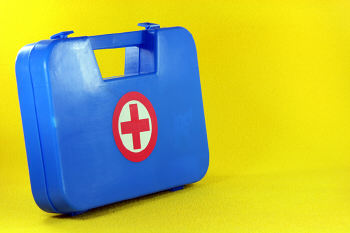Tips for Staying Healthy While Traveling
by L.J. Bothell
The last thing you want to consider when you’re planning your next big trip is getting sick. The best time to think about it, though, is while you are in the planning stage. Few things are more unpleasant than getting off the plane halfway around the world with a sore throat, trying to hike with that twisted ankle, or discovering too few Band-Aids too late.
Germs
First, consider how you plan to travel – plane, train, or bus. You will be crammed into a sardine-like space with lots of unknown people who may have hygiene and health issues. If you’re prone to colds, you’ll often pick one up in the canned air of an airplane. Trains might offer more room for movement, but then people stroll by with their germs. Even airports harbor all sorts of fun germs, especially in the long security lines.
Begin your journey in good health. It’s always tempting to pack at the last minute, get to sleep late the night before, and eat whatever fast food is handy for breakfast. Don’t do this! Pack a couple of days ahead and do a one-half hour check through the evening before, then go to bed at your usual time, if not earlier.
Drink extra water the day before your trip and when you leave, have a solid, balanced dinner and a healthy breakfast with fruits and vegetables. Carry a health bar or some trail mix and a baggie of carrots to snack on before you clear security checkpoints (in case they don’t let you take fresh food through). When in travel terminal shops and restaurants, look for fresh food or healthy alternatives, and replenish your water whenever you can.
Be prepared for the onslaught of germs combined with canned, over-circulated air. There are preventative products on the market that can help you boost your immunity system with a big dose of vitamins and herbs. Or, you can grab a health smoothie that does the same. When on a plane or train, consider using a small face mask, or dampen a bandana and place it over your nose and mouth for half-hour increments. Since you are made up primarily of water, when you get dehydrated, you become more susceptible to picking up viruses. Keep drinking water so that you feel pleasantly sloshy but not bursting.
Exercise
 Traveling puts you on the move. It’s tempting not to take care of yourself. You may be seated for long stretches, contorted while carrying heavy bags, jet-lagged from strange schedules. Treat your body right to get the most out of it during your trip.
Traveling puts you on the move. It’s tempting not to take care of yourself. You may be seated for long stretches, contorted while carrying heavy bags, jet-lagged from strange schedules. Treat your body right to get the most out of it during your trip.
Start by limbering up before you get to your seat. You can easily and publicly do a few stretches while in the boarding lines, such as extending your arms in front of you, with your fingers laced, then raising them above your head. You can also do a simple toe-touch while standing, and while seated, bring your left knee up to your chest, then your right. Carefully lean forward so that your back is rounded and your head is hanging loose, letting your back and neck muscles relax for 30-60 seconds.
Do a little light stretching before you hoist your bags onto your back or take long walks – best done in the mornings after you’ve been up a few minutes. Include toe-touching, arm and back lengthening stretches, knee-bends and ankle rolls for muscle flexibility. Before bed, you might also do some neck and shoulder stretches, and a five minute foot massage. If possible, make a 15-20 minute morning walk part of your wake-up call so that you can feel your most alert before your day really gets going.
Other simple muscle relaxers include gentle head tilts or rolls, shoulder rolls, leg stretches, etc. Several of these can be done while seated so that you keep your circulation active and your muscles loose. Some places to check for airplane stretches and exercise tips are:
- American Physical Therapy Association In-Flight Exercise Guide
- Airplane Stretches from Road & Travel Magazine
- Airplane Stretches from Shelter Online
- How to Exercise on a Plane from eHow
- How to Exercise in Your Airplane Seat from BNET
- “Airplane Yoga” by Rachel Lehmann-Haupt and Bess Abrahams
First-Aid
 Bring your own first-aid basics with you in a form you can carry easily and conveniently. Start with pain reliever, Band-Aids, antiseptic ointment, a few Wet Ones, moleskin, your favorite stomach remedy, and whatever prescriptions you require. Make sure you label everything in your primary language and in your destination language. Consider bringing multi vitamins, Zicam, Vitamin C and a small tube of Airborne.
Bring your own first-aid basics with you in a form you can carry easily and conveniently. Start with pain reliever, Band-Aids, antiseptic ointment, a few Wet Ones, moleskin, your favorite stomach remedy, and whatever prescriptions you require. Make sure you label everything in your primary language and in your destination language. Consider bringing multi vitamins, Zicam, Vitamin C and a small tube of Airborne.
Include what health assistance you can expect to find at your destination as part of your pre-travel research. This is important if you come down with a head cold after you arrive and need cough medicine, for instance. Don’t expect the hotel to assist you – information can be different depending on the class of hotel. For example, Paris has a pharmacy every few blocks, while Rome and Venice have them spaced further apart.
Check out the website of IAMAT (International Association for Medical Assistance to Travelers – free but donation suggested). Helpful information on doctors and fees you might need around the world, plus a membership card, health charts, etc.
» Practical and hands-on first aid training courses for the outdoors and for the traveler with Will4Adventure.
Get the most out of your next big trip. Preparation and self care are easy. The better you feel, the more you’ll do and remember. Hiking the Cinque Terre is no fun with a blasting head cold, nor is spending an overnight train journey huddled sick in bed. It puts a real crimp on your museum walking plans if your muscles get and stay stiff from too much crammed sitting and not enough relaxed sleeping. You owe it to yourself to stay healthy while you travel. Good luck!
More Information
L.J. Bothell is a graphic designer/writer with marketing communications emphasis who lives and temps/freelances in Seattle, Washington. Contact ljwrite at att dot net with the title in the subject header with questions.